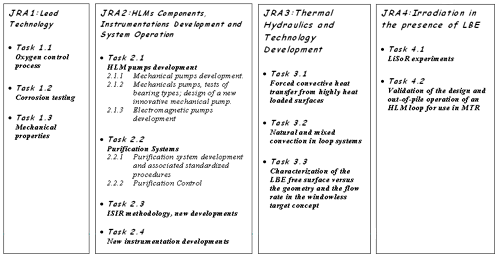OVERVIEW
The Joint Research Activities (JRA) are technical activities which main objectives are the development and the justification of the technologies needed for the operation of large facilities for future Gen IV reactors and ADS cooled by HLM, the development of the needed components and instrumentation, the study of the liquid metal thermal-hydraulics and the analysis of the effects of irradiation in presence of LBE, homogenizing and completing the results obtained in the other research programmes related to the HLM technologies for nuclear applications.
JOINT RESEARCH ACTIVITIES (JRA)

JOINT RESEARCH ACTIVITY 1: “LEAD TECHNOLOGY”
Responsable person: Juergen Konys, FZK - juergen.konis@imf.fzk.de
Heavy liquid metal cooled nuclear power plants are being considered as serious candidates for future energy
supply worldwide. In fact, the experimental accelerator driven system (XT-ADS), the GIF reactors and EFIT are foreseen to be cooled by heavy liquid lead alloys.
The objective of this joint research activity is the development and validation of technologies, information/data,
needed for the operation of large loop and pool-type lead configurations, that may be required for the realization of future Gen-IV reactors and Accelerator Driven Systems (ADS) like the EFIT.
While a considerable effort is being dedicated to the development of technologies and test procedures in either LBE (in P&T frame) and/or Pb-17Li (in Fusion frame) at international level, only a few are being devoted to pure Pb even though it is a candidate of considerable importance as a coolant/target for high temperature systems.
This JRA represents a significant step towards the development of the needed technologies and the required know-how for next-generation systems by providing data on:
- how to control oxygen in large lead pool-type configurations, including the development of O2;
- sensors for these applications (calibration procedure);
- the estimation of the corrosion behaviour of potential materials in stagnant Pb at T=550°C;
- the influence of Pb on the mechanical properties (tensile, creep rupture) at T=550°C.
JRA1 INVOLVED INSTITUTIONS :: CEA - CIEMAT - CNR-IENI - CNRS - ENEA - FZK - IQS - NRI - SCK·CEN
JOINT RESEARCH ACTIVITY 2:
“HLM COMPONENTS, INSTRUMENTATION DEVELOPMENT AND SYSTEM OPERATION”
Responsable person: Christian Latgé, CEA - christian.latge@cea.fr
In order to be able to use the full potential of existing facilities, which will be adapted to the future needs, and in
order to improve the reliability of the experimental facilities and their major components and finally to define and validate the good up to date operating procedures, this Joint Research Activity has the following main objectives:
- to define and to develop optimised systems and components dedicated for future experiments;
- to characterize the features and the potentialities of existing dedicated instrumentation;
- to develop new instrumentation for optimised experimental facilities;
- to define and to validate experimentally, if necessary, the basic operational procedures;
- to develop a standardized In Service Inspection and Repair methodology well adapted to the design support.
Thus the general activity related to this JRA will be based on a critical analysis of operational feedback from numerous R&D experiences performed through past or on going test programs.
This step will allow the identification of paths for improvement and by associated experimental activity, the components and systems will be improved. Moreover, recommendations on operation procedures could be deduced also and validated on on-going experiments. Through the NA2 and NA3, the benefit of this approach will be spread out in all European laboratories in order to contribute to the excellence of European National Laboratories.
JRA2 INVOLVED INSTITUTIONS :: CEA - ENEA - FZD - IPUL - SCK·CEN
JOINT RESEARCH ACTIVITY 3:
"LIQUID METAL THERMAL-HYDRAULICS"
Responsable person: Robert Stieglitz, FZK - robert.stieglitz@iket.fzk.de
The objective of this joint research activity is to evaluate the topics here below in the context of three, rather generic, experiments, in order to supply a fundamental input data to the design activities currently underway in other European programmes and dealing with rather specific technical issues. The three proposed experiments are conducted by at least two associations with a good experience in liquid metals and are followed by the liquid metal community.
These are:
- single phase turbulent heat transfer from highly heat loaded surfaces;
- single phase buoyant and mixed convection in loop systems;
- free surface shaping in heavy liquid metal flows in dependence of the geometric and fluid dynamic boundary conditions.
JRA3 INVOLVED INSTITUTIONS :: CEA - ENEA - FZK - KTH - PSI - SCK·CEN
JOINT RESEARCH ACTIVITY 4: "IRRADIATION IN PRESENCE OF LBE"
Responsable person: Friedrich Groeschel, PSI - friedrich.groeschel@psi.ch
The aim of this JRA is to cover a major lack in the capabilities of the existing facilities to perform experiments
combining HLM and radioactivity. Hence the development of a high temperature lead alloy loop is planned to be installed in a MTR reactor BR2 under the leadership of SCK•CEN.
The in-pile HLM loop should be designed in such a way that it can be used for the following purposes that are common to the development of GEN-IV LFR and Pb(-Bi) ADS whereby some of these points are as well covered in LiSoR.
- LFR materials compatibility with Pb(-Bi) under irradiation:
- cladding, reactor internals, heat exchangers, pumps;
- corrosion.
- Pb-Bi conditioning and purification technologies in radio-active conditions.
- Radiation effects on coolant chemistry control:
- oxygen sensors and oxygen control;
- 210Po control;
- corrosion products control.
- Reactor components in Pb(-Bi) under irradiation:
- ultrasonic sensors for in-service inspection;
- liquid metal pumps;
- instrumentation.
NA4 INVOLVED INSTITUTIONS :: FZK - SCK•CEN - PSI
